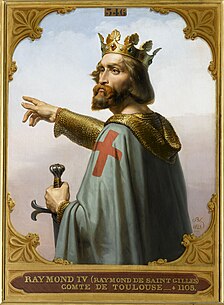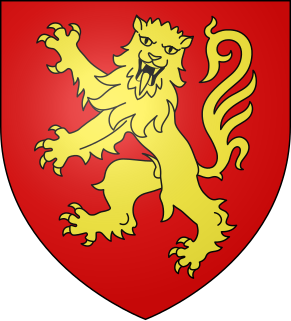Raymond II (died 924) was the Count of Toulouse, Nîmes, and Albi. He was the, probably elder, son of Odo of Toulouse and Garsenda.

The Count of Toulouse was the ruler of Toulouse during the 8th to 13th centuries. Originating as vassals of the Frankish kings, the hereditary counts ruled the city of Toulouse and its surrounding county from the late 9th century until 1270. The counts and other family members were also at various times counts of Quercy, Rouergue, Albi, and Nîmes, and sometimes margraves of Septimania and Provence. Count Raymond IV founded the Crusader state of Tripoli, and his descendants were also counts there. They reached the zenith of their power during the 11th and 12th centuries, but after the Albigensian Crusade the county fell to the kingdom of France, nominally in 1229 and de facto in 1271.

Albi is a commune in southern France. It is the prefecture of the Tarn department, on the river Tarn, 85 km northeast of Toulouse. Its inhabitants are called Albigensians. It is the seat of the Archbishop of Albi. The episcopal city, around the Cathedral Sainte-Cécile, was added to the UNESCO list of World Heritage Sites in 2010.
In 886, at the death of Bernard the Calf, he succeeded to the comital title in Nîmes and Albi while Odo his father received the county of Toulouse. In 898, his father made him Count of Rouergue. In 906, Odo gave Rouergue to his younger son Ermengol and made Raymond co-count in Toulouse. In 918, Odo died and Toulouse went to Raymond, while Rouergue, along with Nîmes and Albi, went to Ermengol. Raymond also received his father's title of Duke of Septimania. He died in 924 and left his titles to his son Raymond Pons.

This is a list of the counts of Rouergue.
Ermengol (870-937) was a son of Odo of Toulouse and Garsindis. His father gave him the County of Rouergue and Quercy in 906 and he governed it to his death. His brother was Raymond II of Toulouse and together they governed the vast patrimony of their house in the first half of the tenth century.
Raymond married Guinidilda, daughter of Wilfred II Borrel, Count of Barcelona. Their only child was Raymond Pons.
The Count of Barcelona was the ruler of Catalonia for much of Catalan history, from the 9th century until the 15th century.
Raymond Pons, who may be numbered Raymond III or Pons I, was the Count of Toulouse from 924.
This page is based on this
Wikipedia article Text is available under the
CC BY-SA 4.0 license; additional terms may apply.
Images, videos and audio are available under their respective licenses.
Raymond of Toulouse may refer to:

The Trencavel was an important noble family in Languedoc between the 10th and 13th centuries. The name "Trencavel" began as a nickname and later became the family surname. The name may derive from the Occitan words for "Nutcracker". The name was traditionally restricted in actual use only to those family members named Raymond, but the last Trencavel viscount, Raymond II, preferred the surname over his given name and adopted it for his charters.

Rudolph or Rudolf was the elected King of France from 923 until his death in 936. Prior to his election as king, he was Duke of Burgundy and Count of Troyes from 921. He was the son of Richard, Duke of Burgundy, and Adelaide of Auxerre, and inherited the Duchy of Burgundy from his father. He married Emma of France, daughter of king Robert I of France. He is frequently confused with his uncle Rudolph I of Burgundy.
Bernard II was the Count of Barcelona, Girona and Margrave of Gothia and Septimania from 865 to 878.
Raymond III, sometimes numbered Raymond II, was the count of Rouergue and Quercy from 961 to his death. Raymond achieved a suzerainty over several neighbouring counties and successfully titled himself margrave of Septimania. He was the son and successor of Raymond II.
Raymond II, sometimes numbered Raymond I was the count of Rouergue and Quercy from 937 to his death. He was the son of Ermengol of Rouergue and Adelaide. Under Raymond, Rouergue achieved a suzerainty over neighbouring counties and he successfully titled himself Margrave (marchio) of Septimania.
Pons (II) William was the Count of Toulouse from 1037. He was the eldest son and successor of William III Taillefer and Emma of Provence. He thus inherited the title marchio Provincæ. He is known to have owned many allods and he relied on Roman, Salic, and Gothic law.
William III Taillefer was the Count of Toulouse, Albi, and Quercy from 972 or 978 to his death. He was the first of the Toulousain branch of his family to bear the title marchio, which he inherited (c.975) from Raymond II of Rouergue.
Odo was the Count of Toulouse from 872 to 918 or 919, when he died.
Raymond I was the Count of Limoges, Rouergue and Quercy, and Toulouse and Albi. He was the younger son of Fulcoald of Rouergue and Senegund, niece of William of Gellone through his sister Alda.
Bernard II, known as the Calf, was the Count of Toulouse, Rouergue, Limoges, Nîmes, Carcassonne, Razès, and Albi. He was the son of Raymond I and Bertha. The dates of his reign are disputed: either 865–877 or 864–872.
Raymond III is the designation assigned to distinct or possibly-distinct Counts of Toulouse in the mid-to-late 10th century. Recent scholarship has overturned the traditional account of the counts during this period without consensus arising for a new reconstruction.
Hugh may be the name of a count of Count of Toulouse, Nîmes, Quercy, and Albi in the third quarter of the 10th century, and perhaps identical to a Bishop Hugh. He was the son of Raymond III, Count of Toulouse and probably grandson of Raymond Pons.
The title Prince of Gothia or Prince of the Goths was a title of nobility, sometimes assumed by its holder as a sign of supremacy in the region of Gothia and sometimes bestowed by the sovereign of West Francia to the principal nobleman in the south of the realm, in the ninth and tenth centuries. Sometimes hereditary and sometimes not, the title has been rendered in English as Duke of Septimania or Duke of Gothia. A similar or the same "office" was often held with the title comes marcæ Hispanicæ: "Count of the Spanish March." The title was also a chronicler's device and, as presented in some chronicles, may never have been used in any official capacity.
Raymond I Trencavel was the Viscount of Agde and Béziers from 1130 and Viscount of Albi, Carcassonne, and Razès from 1150. He was a member of the Trencavel family, ruling the lands of the elder branch.

The House of Toulouse, sometimes called House of Saint-Gilles, is the name of the dynasty that ruled the County of Toulouse.






